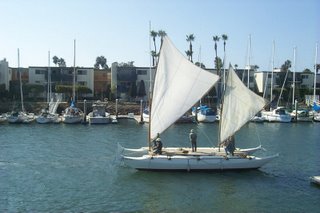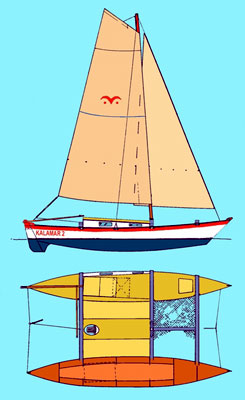Another Mississippi Backwoods Drifter is currently coming together in the shop, this one for a customer in Louisiana. I'll update on this particular project as it nears completion, but writing about the sharpie type of sailboat yesterday got me thinking about this particular design again.

The latest Backwoods Drifter under construction
A Flat-Bottomed Design:
Yesterday I wrote about a unique type of sailboat with a flat bottom, called a Sharpie. Flat-bottom craft of many other sizes and types have been around a lot longer than the specialized sharpie sailing vessels. As a stable cargo carrier nothing beats a flat bottomed vessel and ancient versions have been unearthed throughout the world and are still found in use today, from giant barges pushed or pulled by diesel towboats to the ubiquitous outboard-driven john boat skiffs that are so popular among fishermen.
In 1998 I built a 12-foot stitch and glue wooden john boat for my father to replace the aging and heavy fiberglass model he had owned since my childhood. This older johnboat was a better design for creek fishing than many of the newer models available today, as it was narrow and therefore easier to paddle than john boats designed strictly for accommodating an outboard motor. I based the new wooden boat loosely on the lines of this older johnboat, staying with the 12-foot overall length, the 30-inch maximum width on the flat bottom hull, and the maximum beam at the gunwales of 40-inches. Although my dad used it with a 3.5 hp outboard for lake fishing, my canoeing buddy, Ernest Herndon and I took it out for a paddle of several miles on a large lake and found it quite easy to move along. Ernest asked me if I could design a similar boat with double ends, like the original johnboats and bateaus from the days before the advent of outboard motors. The result of this casual conversation, completed a few weeks later, was the original Backwoods Drifter, which turned out to be everything Ernest and I expected and more.
Ernest Herndon’s enthusiasm for this boat remains strong ten years later, and he has used it for countless day trips and a few multi-day river camping trips across the Deep South. Experienced canoeists and kayakers might at first glance look at this flat-bottomed design and dismiss it as oversimplified and unsophisticated. But besides the barge and johnboat, flat bottom craft are still used in rough, windswept bays and even in unprotected coastal waters. The flat-bottomed dory is one type that can handle breaking waves, and some of these are used off surf-bound beaches and to negotiate some of the most difficult river rapids in conditions that would destroy most boats. And as I've already written, the Sharpie type of sailboat evolved as a flat-bottom working vessel designed to carry loads disproportionate to its size, but is still found in use as a cruising yacht due to its extreme shallow draft and seaworthieness.
The key to designing a good flat-bottomed boat is incorporating the right amount of rocker in the bottom and flare in the sides for the intended purpose. Extreme rocker along the bottom is good for rough water and quick maneuverability, such as in rapids, but the trade off is decreased tracking ability, and load-carrying capacity. As the speed and ease of paddling increases with waterline length, it is an advantage to have a fairly long waterline with just enough rocker at the ends to allow quick turning. A strong upswept sheer with raised bow and stern can be an advantage in a choppy, breaking sea, but too much freeboard in the ends creates excessive windage and makes the boat hard to control in breezy conditions. Since the Backwoods Drifter is designed for quieter, more protected waters, the sheer has been kept a bit flatter and the ends, though square, are substantially narrower than the amidships sections.
Some might wonder why not bring the ends to a point, like a canoe or a pirouge, but to do so in such a short length would compromise a lot of the stability of this boat. One of the chief advantages of the design over a canoe is the stand-up stability. With a bottom that is still 18 inches wide at each end, the Backwoods Drifter is much more stable than a canoe this short, which is why most canoes are at least 14 feet or longer. Unlike in a canoe or pirouge, in the drifter you can stand in any part of the bottom or sit right out on the end platforms without fear of capsize.

This photo of a finished Drifter shows the long flat midships section
On the subject of stability, the flat-bottom design, of course, has lots of initial stability. Although many flat-bottom boats are lacking in secondary stability, that doesn’t have to be the case if the right amount of flare is incorporated into the hull sides. This flare allows the boat to be paddled in a “heeled-over” angle, putting the chine edge into the water to form a “V,” which aids in tracking, and providing a stable surface for the boat to grip the water in this position. The Backwoods Drifter is stable on its side right up to the point where the gunwale dips into the water. Paddling in the leaned position is ideal for solo river travel, as you can reach the water easier and use a guide or J-stroke to paddle on the low side of the boat.
The symmetrical ends and sliding middle seat makes it easy to set up the Backwoods Drifter for solo or tandem paddling. A solo paddler can sit on the middle seat with it moved aft or with two paddlers one can sit on one of the platforms (which would then become the stern) with the forward paddler on the middle seat slid to the forward position. Since like a canoe, both ends are the same, either end of the boat can be the bow or stern. On a gentle flowing backwoods stream like Mississippi’s Black Creek – the kind of waterway this boat is perfect for – one can sit or stand, paddle leaned or upright, and spin around to drift backwards or turn in slow circles while looking up at the overhanging trees and daydreaming. On such streams the boat allows you to become one with the water, and it's this connection that is what backwoods drifting is all about.
If you want to see more photos of this design you can find them on my Backwoods Drifter page.



































